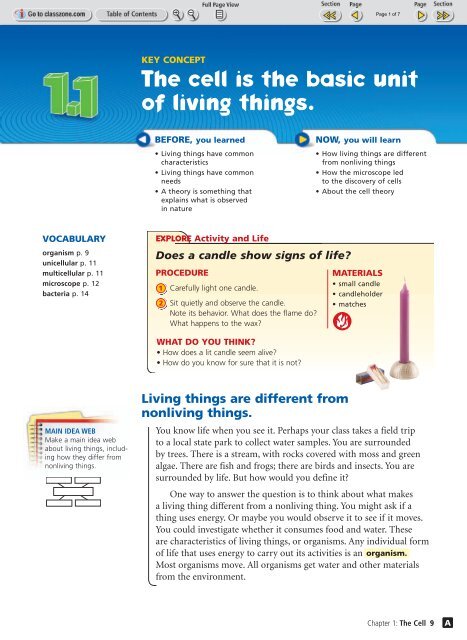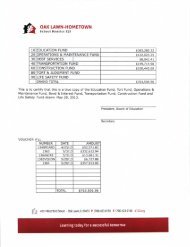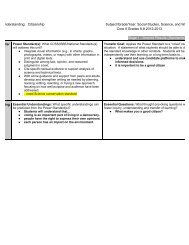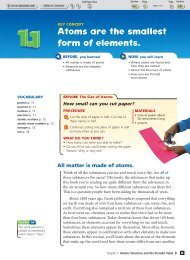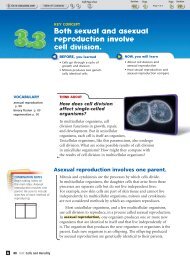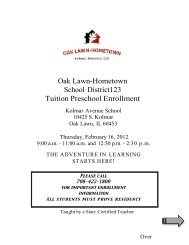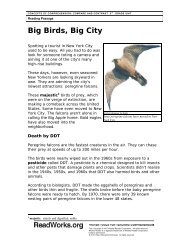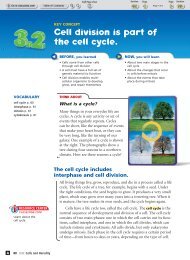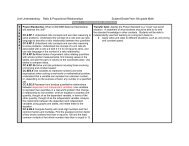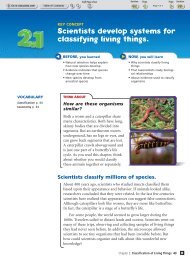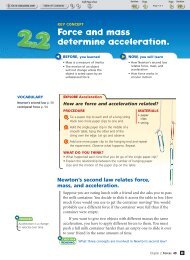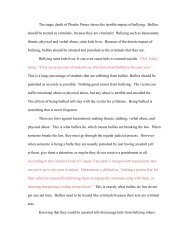The cell is the basic unit of living things. - Durant Road Middle School
The cell is the basic unit of living things. - Durant Road Middle School
The cell is the basic unit of living things. - Durant Road Middle School
Create successful ePaper yourself
Turn your PDF publications into a flip-book with our unique Google optimized e-Paper software.
KEY CONCEPT<br />
<strong>The</strong> <strong>cell</strong> <strong>is</strong> <strong>the</strong> <strong>basic</strong> <strong>unit</strong><br />
<strong>of</strong> <strong>living</strong> <strong>things</strong>.<br />
BEFORE, you learned<br />
•Living <strong>things</strong> have common<br />
character<strong>is</strong>tics<br />
•Living <strong>things</strong> have common<br />
needs<br />
•A <strong>the</strong>ory <strong>is</strong> something that<br />
explains what <strong>is</strong> observed<br />
in nature<br />
NOW, you will learn<br />
• How <strong>living</strong> <strong>things</strong> are different<br />
from non<strong>living</strong> <strong>things</strong><br />
• How <strong>the</strong> microscope led<br />
to <strong>the</strong> d<strong>is</strong>covery <strong>of</strong> <strong>cell</strong>s<br />
• About <strong>the</strong> <strong>cell</strong> <strong>the</strong>ory<br />
VOCABULARY<br />
organ<strong>is</strong>m p. 9<br />
uni<strong>cell</strong>ular p. 11<br />
multi<strong>cell</strong>ular p. 11<br />
microscope p. 12<br />
bacteria p. 14<br />
EXPLORE Activity and Life<br />
Does a candle show signs <strong>of</strong> life?<br />
PROCEDURE<br />
1<br />
2<br />
Carefully light one candle.<br />
Sit quietly and observe <strong>the</strong> candle.<br />
Note its behavior. What does <strong>the</strong> flame do?<br />
What happens to <strong>the</strong> wax?<br />
MATERIALS<br />
•small candle<br />
• candleholder<br />
•matches<br />
WHAT DO YOU THINK?<br />
• How does a lit candle seem alive?<br />
• How do you know for sure that it <strong>is</strong> not?<br />
MAIN IDEA WEB<br />
Make a main idea web<br />
about <strong>living</strong> <strong>things</strong>, including<br />
how <strong>the</strong>y differ from<br />
non<strong>living</strong> <strong>things</strong>.<br />
Living <strong>things</strong> are different from<br />
non<strong>living</strong> <strong>things</strong>.<br />
You know life when you see it. Perhaps your class takes a field trip<br />
to a local state park to collect water samples. You are surrounded<br />
by trees. <strong>The</strong>re <strong>is</strong> a stream, with rocks covered with moss and green<br />
algae. <strong>The</strong>re are f<strong>is</strong>h and frogs; <strong>the</strong>re are birds and insects. You are<br />
surrounded by life. But how would you define it?<br />
One way to answer <strong>the</strong> question <strong>is</strong> to think about what makes<br />
a <strong>living</strong> thing different from a non<strong>living</strong> thing. You might ask if a<br />
thing uses energy. Or maybe you would observe it to see if it moves.<br />
You could investigate whe<strong>the</strong>r it consumes food and water. <strong>The</strong>se<br />
are character<strong>is</strong>tics <strong>of</strong> <strong>living</strong> <strong>things</strong>, or organ<strong>is</strong>ms. Any individual form<br />
<strong>of</strong> life that uses energy to carry out its activities <strong>is</strong> an organ<strong>is</strong>m.<br />
Most organ<strong>is</strong>ms move. All organ<strong>is</strong>ms get water and o<strong>the</strong>r materials<br />
from <strong>the</strong> environment.<br />
Chapter 1: <strong>The</strong> Cell 9<br />
EA
Character<strong>is</strong>tics <strong>of</strong> Life<br />
Living <strong>things</strong> have <strong>the</strong>se character<strong>is</strong>tics:<br />
• organization<br />
• <strong>the</strong> ability to develop and grow<br />
• <strong>the</strong> ability to respond to <strong>the</strong> environment<br />
• <strong>the</strong> ability to reproduce<br />
An organ<strong>is</strong>m’s body must be organized in a way that enables it to<br />
meet its needs. Some organ<strong>is</strong>ms, like bacteria, are very simple. A more<br />
complex organ<strong>is</strong>m, such as <strong>the</strong> kingf<strong>is</strong>her shown in <strong>the</strong> photograph<br />
below, <strong>is</strong> organized so that different parts <strong>of</strong> its body perform different<br />
jobs, called functions. For example, a kingf<strong>is</strong>her has wings for flying,<br />
a heart for pumping blood, and eyes for seeing.<br />
Ano<strong>the</strong>r character<strong>is</strong>tic <strong>of</strong> organ<strong>is</strong>ms <strong>is</strong> that <strong>the</strong>y grow and, in<br />
most cases, develop into adult forms. Some organ<strong>is</strong>ms change a great<br />
deal in size and appearance throughout <strong>the</strong>ir lifetimes, whereas o<strong>the</strong>rs<br />
grow and change very little. Organ<strong>is</strong>ms also respond to <strong>the</strong> world outside<br />
<strong>the</strong>m. Think <strong>of</strong> how <strong>the</strong> pupils <strong>of</strong> your eyes get smaller in bright<br />
light. Finally, organ<strong>is</strong>ms can reproduce, producing new organ<strong>is</strong>ms that<br />
are similar to <strong>the</strong>mselves.<br />
Check Your Reading<br />
What four character<strong>is</strong>tics are common to all <strong>living</strong> <strong>things</strong>?<br />
APPLY Identify three <strong>living</strong><br />
<strong>things</strong> in th<strong>is</strong> photograph.<br />
How do <strong>the</strong>y meet <strong>the</strong>ir<br />
needs?<br />
Needs <strong>of</strong> Life<br />
Organ<strong>is</strong>ms cannot carry out <strong>the</strong> activities that characterize life without<br />
a few necessities: energy, materials, and <strong>living</strong> space. What does<br />
it mean to need energy? You know that if you want to run a race,<br />
you need energy. But did you know that your body also needs energy<br />
to sleep or to brea<strong>the</strong> or even to think? All organ<strong>is</strong>ms require a steady<br />
supply <strong>of</strong> energy to stay alive. Where does th<strong>is</strong> energy come from,<br />
and how does an organ<strong>is</strong>m get it?<br />
Food <strong>is</strong> a source <strong>of</strong><br />
energy and<br />
materials.<br />
Water provides<br />
materials and<br />
<strong>living</strong> space.<br />
<strong>The</strong> energy used by almost all forms <strong>of</strong> life on<br />
Earth comes from <strong>the</strong> Sun. Some organ<strong>is</strong>ms, like<br />
plants and some bacteria, are able to capture th<strong>is</strong><br />
energy directly. Your body, like <strong>the</strong> bodies <strong>of</strong> o<strong>the</strong>r<br />
animals, uses food as a source <strong>of</strong> energy. <strong>The</strong> food<br />
animals eat comes from plants or from organ<strong>is</strong>ms<br />
that eat plants. Food also provides <strong>the</strong> materials<br />
necessary for growth and reproduction. <strong>The</strong>se materials<br />
include substances such as carbon dioxide,<br />
nitrogen, oxygen, and water. Finally, all organ<strong>is</strong>ms<br />
need space to live and grow. If any one <strong>of</strong> <strong>the</strong>se<br />
requirements <strong>is</strong> m<strong>is</strong>sing, an organ<strong>is</strong>m will die.<br />
EA<br />
10 Unit: Cells and Heredity
All <strong>living</strong> <strong>things</strong> are made <strong>of</strong> <strong>cell</strong>s.<br />
<strong>The</strong> <strong>cell</strong> <strong>is</strong> <strong>the</strong> smallest <strong>unit</strong> <strong>of</strong> a <strong>living</strong> thing. Some organ<strong>is</strong>ms are<br />
made <strong>of</strong> a single <strong>cell</strong>. <strong>The</strong>se organ<strong>is</strong>ms are uni<strong>cell</strong>ular and usually<br />
too small for you to see directly. Pond water <strong>is</strong> full <strong>of</strong> tiny uni<strong>cell</strong>ular<br />
organ<strong>is</strong>ms. Most <strong>of</strong> <strong>the</strong> organ<strong>is</strong>ms you can see, such as a frog or a<br />
water lily, are made up <strong>of</strong> many <strong>cell</strong>s. Organ<strong>is</strong>ms made up <strong>of</strong> many<br />
<strong>cell</strong>s are called multi<strong>cell</strong>ular organ<strong>is</strong>ms.<br />
<strong>The</strong> needs and character<strong>is</strong>tics <strong>of</strong> a single <strong>cell</strong> in a uni<strong>cell</strong>ular<br />
organ<strong>is</strong>m are <strong>the</strong> same as those for any organ<strong>is</strong>m. Each <strong>of</strong> <strong>the</strong> tiny<br />
single-<strong>cell</strong>ed organ<strong>is</strong>ms found in a drop <strong>of</strong> pond water performs all<br />
<strong>the</strong> activities that characterize life. Multi<strong>cell</strong>ular organ<strong>is</strong>ms, like a frog<br />
or a water lily, have bodies that are more complex. Different parts <strong>of</strong><br />
<strong>the</strong> body <strong>of</strong> a multi<strong>cell</strong>ular organ<strong>is</strong>m perform different functions. A<br />
water lily’s roots hold it in <strong>the</strong> soil and its leaves capture energy from<br />
<strong>the</strong> Sun. A frog moves with its arms and legs and eats with its mouth.<br />
Multi<strong>cell</strong>ular organ<strong>is</strong>ms have different types <strong>of</strong> <strong>cell</strong>s that make up<br />
<strong>the</strong>ir body parts and help <strong>the</strong> organ<strong>is</strong>ms meet <strong>the</strong>ir needs. Roots are<br />
made <strong>of</strong> root <strong>cell</strong>s, which are different from leaf <strong>cell</strong>s. Muscle <strong>cell</strong>s<br />
have special parts that allow <strong>the</strong>m to move. In a multi<strong>cell</strong>ular organ<strong>is</strong>m,<br />
many <strong>cell</strong>s work toge<strong>the</strong>r to carry out <strong>the</strong> <strong>basic</strong> activities <strong>of</strong> life.<br />
VOCABULARY<br />
Add four squares for uni<strong>cell</strong>ular<br />
and multi<strong>cell</strong>ular<br />
to your notebook. You<br />
may want to add to your<br />
l<strong>is</strong>ts <strong>of</strong> character<strong>is</strong>tics and<br />
examples as you read<br />
through <strong>the</strong> chapter.<br />
Multi<strong>cell</strong>ular and Uni<strong>cell</strong>ular Organ<strong>is</strong>ms<br />
Both multi<strong>cell</strong>ular and uni<strong>cell</strong>ular organ<strong>is</strong>ms<br />
live in th<strong>is</strong> pond.<br />
<strong>The</strong>re are many<br />
uni<strong>cell</strong>ular<br />
organ<strong>is</strong>ms in<br />
th<strong>is</strong> drop <strong>of</strong> pond<br />
water, magnified 75.<br />
<strong>The</strong> frog and water lilies<br />
are multi<strong>cell</strong>ular<br />
organ<strong>is</strong>ms.<br />
What are some differences between <strong>the</strong> multi<strong>cell</strong>ular and<br />
uni<strong>cell</strong>ular organ<strong>is</strong>ms in th<strong>is</strong> photograph? some similarities?<br />
Chapter 1: <strong>The</strong> Cell 11<br />
EA
eading tip<br />
<strong>The</strong> word microscopic <strong>is</strong> an<br />
adjective made from <strong>the</strong><br />
noun microscope. Things<br />
that are microscopic are too<br />
small to see without <strong>the</strong> use<br />
<strong>of</strong> a microscope.<br />
<strong>The</strong> microscope led to <strong>the</strong> d<strong>is</strong>covery <strong>of</strong> <strong>cell</strong>s.<br />
Most <strong>cell</strong>s are microscopic, too small to see without <strong>the</strong> aid <strong>of</strong> a<br />
microscope. A microscope <strong>is</strong> an instrument which makes an object<br />
appear bigger than it <strong>is</strong>. It took <strong>the</strong> invention <strong>of</strong> th<strong>is</strong> relatively simple<br />
tool to lead to <strong>the</strong> d<strong>is</strong>covery <strong>of</strong> <strong>cell</strong>s. In <strong>the</strong> 1660s, Robert Hooke<br />
began using microscopes to look at all sorts <strong>of</strong> materials. Anton van<br />
Leeuwenhoek took up similar work in <strong>the</strong> 1670s. <strong>The</strong>y were among<br />
<strong>the</strong> first people to describe <strong>cell</strong>s.<br />
Robert Hooke gave <strong>the</strong> <strong>cell</strong> its<br />
name. While looking at a sample<br />
<strong>of</strong> cork, a layer <strong>of</strong> bark taken from<br />
an oak tree, he saw a group <strong>of</strong><br />
similarly shaped compartments<br />
that looked to him like tiny empty<br />
rooms, or <strong>cell</strong>s. You can see from<br />
h<strong>is</strong> drawing, shown at right, how<br />
well <strong>the</strong>se <strong>cell</strong>s fit Hooke’s description.<br />
Hooke used a microscope<br />
that magnified objects 30 times<br />
(30). In o<strong>the</strong>r words, objects<br />
appeared thirty times larger than<br />
<strong>the</strong>ir actual size.<br />
Hooke’s Drawing <strong>of</strong> Cells<br />
Robert Hooke publ<strong>is</strong>hed th<strong>is</strong> drawing<br />
<strong>of</strong> dead cork <strong>cell</strong>s in 1665. <strong>The</strong><br />
microscope he used, shown at left,<br />
has two lenses.<br />
<strong>The</strong> bark <strong>cell</strong>s Hooke saw were<br />
actually dead <strong>cell</strong>s, which <strong>is</strong> why <strong>the</strong>y appeared empty. Anton van<br />
Leeuwenhoek was one <strong>of</strong> <strong>the</strong> first people to describe <strong>living</strong> <strong>cell</strong>s.<br />
He looked at a drop <strong>of</strong> pond water under a microscope. Imagine h<strong>is</strong><br />
surpr<strong>is</strong>e when he saw that a drop <strong>of</strong> water was full <strong>of</strong> <strong>living</strong> <strong>things</strong>!<br />
Using lenses that could magnify an object almost 300, he observed<br />
tiny uni<strong>cell</strong>ular organ<strong>is</strong>ms like those shown on page 11.<br />
Check Your Reading<br />
How did <strong>the</strong> invention <strong>of</strong> <strong>the</strong> microscope change <strong>the</strong> study<br />
<strong>of</strong> biology?<br />
You can understand how powerful a microscope <strong>is</strong> if you think<br />
<strong>of</strong> how big a penny would be if it were increased in size 30 .It<br />
would be a little bigger than <strong>the</strong> tire <strong>of</strong> a ten-speed bicycle. Enlarged<br />
300 ,that penny would be so big that you would need a tractortrailer<br />
to move it. Magnify your best friend 30 (supposing a height<br />
<strong>of</strong> 1.5 meters, or almost 5 ft), and your friend would appear to be 45<br />
meters (147 ft) tall. That’s almost <strong>the</strong> height <strong>of</strong> Niagara Falls. Change<br />
<strong>the</strong> magnification to 300 , and your friend would appear to be 450<br />
meters (1470 ft) tall—taller than <strong>the</strong> Empire State Building.<br />
EA<br />
12 Unit: Cells and Heredity
Cells come from o<strong>the</strong>r <strong>cell</strong>s.<br />
<strong>The</strong> studies <strong>of</strong> Hooke and Leeuwenhoek made people ask if all <strong>living</strong><br />
<strong>things</strong> have <strong>cell</strong>s. People continued to observe samples taken from<br />
all sorts <strong>of</strong> <strong>living</strong> matter. <strong>The</strong>y continued to find <strong>cell</strong>s, although <strong>of</strong>ten<br />
<strong>the</strong>se <strong>cell</strong>s looked very different from one ano<strong>the</strong>r. Still, it was clear<br />
that all <strong>living</strong> matter was made <strong>of</strong> <strong>cell</strong>s.<br />
<strong>The</strong>re was ano<strong>the</strong>r important question scient<strong>is</strong>ts were trying to<br />
answer: Where do <strong>cell</strong>s come from? <strong>The</strong> answer to th<strong>is</strong> question was<br />
settled by <strong>the</strong> 1850s. People studying all types <strong>of</strong> <strong>living</strong> <strong>cell</strong>s observed<br />
<strong>the</strong> same thing—that <strong>cell</strong>s divide. One <strong>living</strong> <strong>cell</strong> divides into two <strong>living</strong><br />
<strong>cell</strong>s. Here, under <strong>the</strong> microscope, was evidence <strong>of</strong> where <strong>cell</strong>s come<br />
from. Life comes from life—that <strong>is</strong>, one <strong>cell</strong> comes from ano<strong>the</strong>r <strong>cell</strong>.<br />
Check Your Reading<br />
What do scient<strong>is</strong>ts mean when <strong>the</strong>y say that life comes from life?<br />
Your answer should include <strong>the</strong> word <strong>cell</strong>s.<br />
<strong>The</strong> observations and evidence ga<strong>the</strong>red over a long time by many<br />
scient<strong>is</strong>ts are summarized in <strong>the</strong> three concepts <strong>of</strong> <strong>the</strong> <strong>cell</strong> <strong>the</strong>ory:<br />
1 Every <strong>living</strong> thing <strong>is</strong> made <strong>of</strong> one or more <strong>cell</strong>s.<br />
2 Cells carry out <strong>the</strong> functions needed to support life.<br />
3 Cells come only from o<strong>the</strong>r <strong>living</strong> <strong>cell</strong>s.<br />
<strong>The</strong> Cell <strong>The</strong>ory<br />
<strong>The</strong> importance <strong>of</strong> <strong>the</strong> <strong>cell</strong> to life<br />
<strong>is</strong> summarized in <strong>the</strong> <strong>cell</strong> <strong>the</strong>ory.<br />
1<br />
Every <strong>living</strong> thing<br />
<strong>is</strong> made up <strong>of</strong> one<br />
or more <strong>cell</strong>s.<br />
A polar bear <strong>is</strong> a<br />
multi<strong>cell</strong>ular<br />
organ<strong>is</strong>m.<br />
2<br />
Cells carry out <strong>the</strong> functions<br />
needed to support life. Fat <strong>cell</strong>s<br />
are animal <strong>cell</strong>s that provide energy as<br />
well as insulation.<br />
3<br />
Cells come only from<br />
o<strong>the</strong>r <strong>living</strong> <strong>cell</strong>s. Each<br />
polar bear cub began as a<br />
single <strong>cell</strong>.<br />
400<br />
Chapter 1: <strong>The</strong> Cell 13<br />
EA
<strong>The</strong> <strong>cell</strong> <strong>the</strong>ory <strong>is</strong> important to <strong>the</strong> study<br />
<strong>of</strong> biology.<br />
<strong>The</strong> importance <strong>of</strong> <strong>the</strong> <strong>cell</strong> <strong>the</strong>ory <strong>is</strong> indicated by <strong>the</strong> word <strong>the</strong>ory.<br />
A scientific <strong>the</strong>ory <strong>is</strong> a widely accepted explanation <strong>of</strong> <strong>things</strong> observed<br />
in nature. A <strong>the</strong>ory must be supported by evidence, including experimental<br />
evidence and observations. A <strong>the</strong>ory proves its value when it<br />
explains new d<strong>is</strong>coveries and observations.<br />
Check Your Reading<br />
What are two character<strong>is</strong>tics <strong>of</strong> scientific <strong>the</strong>ory?<br />
<strong>The</strong>ories are important for a number <strong>of</strong> reasons. Certainly <strong>the</strong>y<br />
sat<strong>is</strong>fy scient<strong>is</strong>ts’ desire to understand <strong>the</strong> natural world, and <strong>the</strong>y<br />
serve as foundations for fur<strong>the</strong>r research and study. <strong>The</strong>ories can also<br />
lead to research that has some practical benefit for society.<br />
<strong>The</strong> milk that you get<br />
from <strong>the</strong> school cafeteria<br />
has been pasteurized so<br />
that it will stay fresh<br />
longer.<br />
Lou<strong>is</strong> Pasteur<br />
<strong>The</strong> work <strong>of</strong> <strong>the</strong> French scient<strong>is</strong>t Lou<strong>is</strong> Pasteur shows how an understanding<br />
<strong>of</strong> <strong>cell</strong> <strong>the</strong>ory can have practical uses. Pasteur lived in <strong>the</strong> 1800s,<br />
when <strong>the</strong>re was no mechanical refrigeration in homes. People were used<br />
to having foods spoil and milk go sour. During th<strong>is</strong> time, many<br />
people died from d<strong>is</strong>eases such as typhoid fever, tuberculos<strong>is</strong>,<br />
and diph<strong>the</strong>ria. Pasteur’s work showed that microscopic organ<strong>is</strong>ms<br />
were involved both in <strong>the</strong> spoilage <strong>of</strong> food and in d<strong>is</strong>ease.<br />
Pasteur observed that milk that turned sour contained<br />
large numbers <strong>of</strong> tiny single-<strong>cell</strong>ed organ<strong>is</strong>ms called bacteria<br />
(bak-TEER-ee-uh). He developed a process, now known as<br />
pasteurization, in which heat <strong>is</strong> used to kill <strong>the</strong> bacteria.<br />
Killing <strong>the</strong> bacteria keeps milk fresh longer. <strong>The</strong> fact that bacteria<br />
cause milk to sour or “sicken” made Pasteur wonder<br />
whe<strong>the</strong>r microscopic organ<strong>is</strong>ms could also be <strong>the</strong> cause <strong>of</strong><br />
sickness in humans and animals.<br />
Bacteria and Spontaneous Generation<br />
Using a microscope to study air, water, and soil, Pasteur found<br />
microorgan<strong>is</strong>ms everywhere. He found bacteria in <strong>the</strong> blood <strong>of</strong> animals,<br />
including people who were sick. Pasteur referred to <strong>the</strong><br />
microorgan<strong>is</strong>ms he observed as “germs.” He realized that an understanding<br />
<strong>of</strong> germs might help prevent d<strong>is</strong>ease. Pasteur’s work led to<br />
<strong>the</strong> first animal vaccinations for cholera and anthrax and to a treatment<br />
for rabies in humans.<br />
At <strong>the</strong> time that Pasteur was doing h<strong>is</strong> research, <strong>the</strong>re were<br />
scient<strong>is</strong>ts who thought that bacteria grew from non<strong>living</strong> materials,<br />
in a process known as spontaneous generation. Pasteur conducted<br />
EA<br />
14 Unit: Cells and Heredity
Pasteur’s Experiments<br />
Pasteur’s experiments showed that bacteria are present in <strong>the</strong> air.<br />
<strong>The</strong>y do not grow spontaneously.<br />
End <strong>of</strong> flask<br />
<strong>is</strong> sealed.<br />
1 Broth <strong>is</strong> boiled to destroy any<br />
2 A few days pass, and <strong>the</strong><br />
<strong>living</strong> bacteria, and <strong>the</strong> flask <strong>is</strong><br />
broth <strong>is</strong> still clear. No<br />
sealed.<br />
bacteria have grown.<br />
3<br />
Two to three days pass,<br />
and <strong>the</strong> broth <strong>is</strong> still clear.<br />
No bacteria have grown.<br />
End <strong>of</strong> flask<br />
<strong>is</strong> broken.<br />
Exposure to air<br />
<strong>is</strong> <strong>the</strong> variable.<br />
1 Broth <strong>is</strong> boiled to destroy any<br />
2 <strong>The</strong> end <strong>of</strong> <strong>the</strong> flask <strong>is</strong><br />
3 Two to three days pass, and<br />
<strong>living</strong> bacteria, and <strong>the</strong> flask <strong>is</strong><br />
broken to expose <strong>the</strong> broth<br />
<strong>the</strong> broth <strong>is</strong> cloudy because <strong>of</strong><br />
sealed.<br />
to <strong>the</strong> air. <strong>The</strong> broth <strong>is</strong> clear.<br />
<strong>the</strong> growth <strong>of</strong> bacteria.<br />
a now-famous series <strong>of</strong> experiments that d<strong>is</strong>proved spontaneous<br />
generation and confirmed <strong>the</strong> <strong>cell</strong> <strong>the</strong>ory. He showed that <strong>cell</strong>s come<br />
only from o<strong>the</strong>r <strong>cell</strong>s. Two <strong>of</strong> those experiments are shown above.<br />
Both began with a sealed flask containing boiled broth. In <strong>the</strong> first<br />
experiment, <strong>the</strong> flask remained sealed, while in <strong>the</strong> second experiment,<br />
<strong>the</strong> top <strong>of</strong> <strong>the</strong> flask was broken to expose <strong>the</strong> contents to air.<br />
Bacteria grew only in <strong>the</strong> second flask.<br />
KEY CONCEPTS<br />
1. Name four character<strong>is</strong>tics <strong>of</strong><br />
<strong>living</strong> <strong>things</strong>.<br />
2. How did <strong>the</strong> microscope<br />
change human understanding<br />
<strong>of</strong> life?<br />
3. Explain <strong>the</strong> three concepts that<br />
make up <strong>the</strong> <strong>cell</strong> <strong>the</strong>ory.<br />
CRITICAL THINKING<br />
4. Analyze Relate <strong>the</strong> character<strong>is</strong>tics<br />
<strong>of</strong> a scientific <strong>the</strong>ory to<br />
<strong>the</strong> <strong>cell</strong> <strong>the</strong>ory.<br />
5. Compare and Contrast<br />
Draw a Venn diagram to compare<br />
and contrast multi<strong>cell</strong>ular<br />
and uni<strong>cell</strong>ular organ<strong>is</strong>ms.<br />
CHALLENGE<br />
6. Syn<strong>the</strong>size Explain how<br />
Pasteur’s experiment supported<br />
<strong>the</strong> <strong>cell</strong> <strong>the</strong>ory and d<strong>is</strong>proved<br />
<strong>the</strong> <strong>the</strong>ory <strong>of</strong> spontaneous<br />
generation.<br />
Chapter 1: <strong>The</strong> Cell 15<br />
EA


